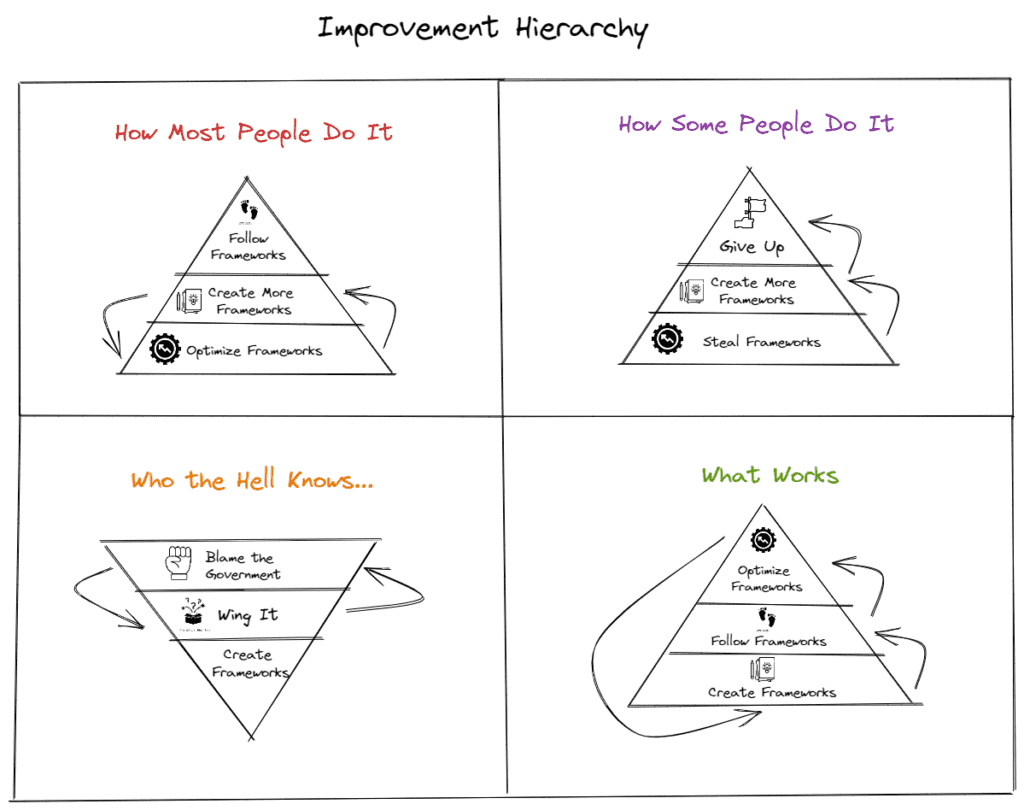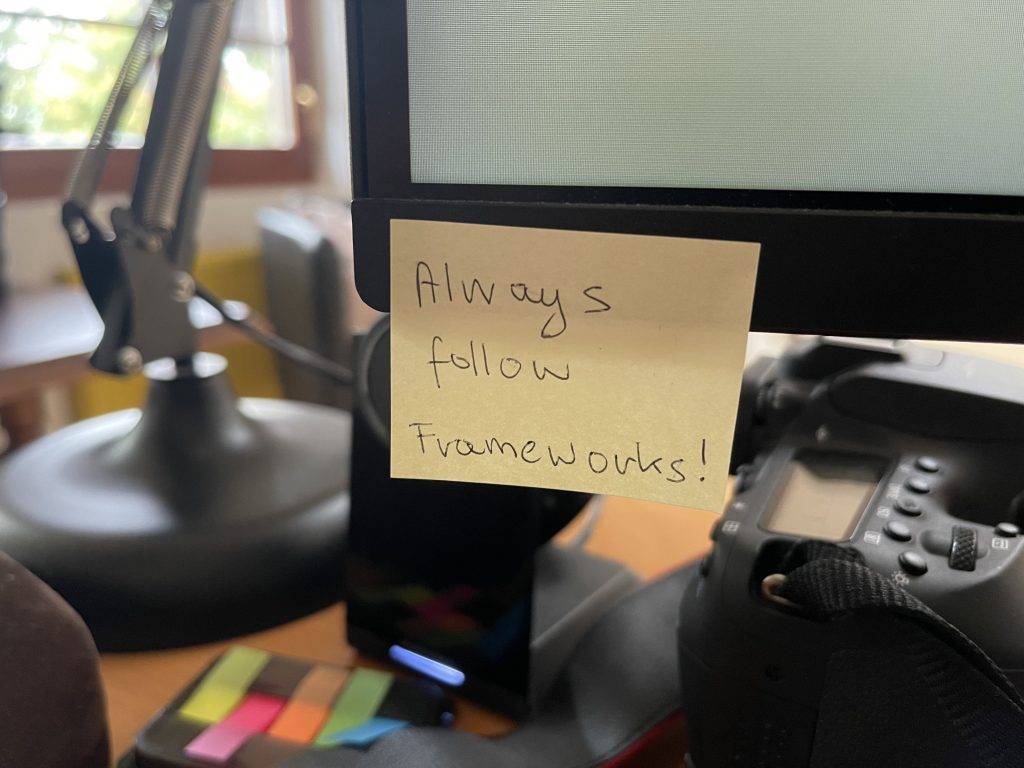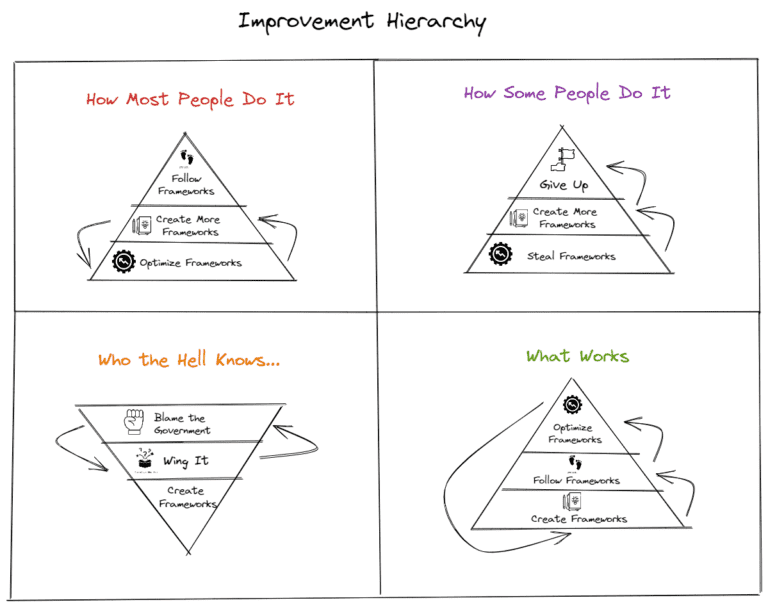Primum non nocere. First do no harm.
How much money are you leaving on a table because you “wing it” and fail to execute what has already proven to work?
I know I lost a bunch of sales for that very reason.
True story from the other day.
I open my eyes and check the watch – it’s 7:37 am. I hop into the shower. The shower brings back a scary thought – I’ve got a sales call at 8 am.
I get out of the bathroom. It’s 7:50 – 10 minutes left.
I hop on Zoom, just 2 minutes late.
I’ll skip the details, as they aren’t crucial to the story.
I didn’t make the sale. But that doesn’t bother me – you win some and lose some.
What bothered me and inspired me to write the article is that I would’ve made the sale if I had followed my proven sales process. If only I didn’t make a fundamental error.
I didn’t screw up because I didn’t “optimize.”
Many of us entrepreneurs are skilled at making things happen, finding shortcuts – solving problems.
But we’re equally good at turning around and screwing up big time the next day.
We wonder why our results are inconsistent.
Why did I make ten sales last month but only five this month?
I know why… I haven’t found “it” yet. The latest gimmick, hack, and formula. I better scour the internet for a new hack.
And you find it, of course, as there’s no shortage of “tactics” or “formulas.”
Yet none of the tactics help you stay consistent because they’re like a cherry on top of a cake. If the cherry doesn’t have a cake to sit on, it falls to the ground.
Why Are Your Results All Over The Place?
I’m not afraid of the warrior that knows thousands of moves but the one who practices one move a thousand times.
Bruce Lee

There’s a famous saying – practice makes perfect. So, we take it and think – “Hey, I’ll practice a few times and switch it up.”
Practice doesn’t make perfect. Deliberate practice makes perfect.
Practice makes certain patterns easier to repeat. Deliberate practice requires a deliberate process.
Oh, and to make sure we’re on the same page word-wise…
Deliberate def.: Done with or marked by full consciousness of the nature and effects; intentional.
You break the rules before you understand the rules
While the truly outstanding results
The process lives in your head and keeps changing.
Unless you put whatever you’re doing on paper (or screen), you’re handicapping yourself. Our brains are great at solving complex problems but prone to lapses in memory.
So, how do we get out of this mess once and for all?
All Roofs Start With a Solid Framework
“It is a profoundly erroneous truism, repeated by all copy-books and by eminent people when they are making speeches that we should cultivate the habit of thinking of what we are doing.
The precise opposite is the case.
Civilization advances by extending the number of important operations which we can perform without thinking about them. Operations of thought are like cavalry charges in a battle — they are strictly limited in number, they require fresh horses, and must only be made at decisive moments.”
Alfred North Whitehead
To get out of this mess, you need an explicit framework.
Framework to your brain is like a software driver to a computer. It sets the default set of actions. It assures not making mistakes but also limits the number of decisions you need to make during the day.
Fewer decisions mean that you can have a higher quality of making more complicated decisions (brain capacity), as the more decisions you make, the lower quality of each particular decision.
Let’s establish some terminology.
Process: a series of actions or operations conducing to an end
Checklist: a list of items to be completed/checked/done.
Framework: A fundamental structure
The opposite of procedure/process is…(according to a dictionary):
-
- Disorganization
-
- Chaos
-
- Confusion
How to Turn an Intuitive Skill Into a Cash Machine
There are two forms of knowledge. Implicit (or tacit) and explicit (or expressive).
Tacit knowledge is your intuitive skill – one you haven’t articulated.
Explicit knowledge is: “any information you can document, store and share with others.”
The military has a great tool called After Action Reviews which they use to turn the implicit lessons & skills into explicit procedures and processes.
Contrary to popular belief, everything you do is a process. It might not be explicit. It may have lots of variances. But it exists.
An explicit framework/process enables us to:
-
- Turn a one-time success into a repeatable one.
-
- Teach others & delegate effectively
-
- Examine the root causes of errors/failure
-
- Optimize/improve systematically
There can be basic frameworks that help you save time daily such as:
-
- Always put your phone in the same place so it’s faster to find it
-
- Always focus when you are locking your door so you don’t need to double-check it
But there are also more complex frameworks like a closer call process.
You need to have the framework in front of your eyes every time you go through the process. Pilots go through the checklist even though they’ve done it hundreds of times and need to memorize the list by heart.

The Nitty-Gritty: Document –> Follow –> Optimize
Wisdom is the profound ability to follow our own advice.
1. Document – Write it down.
The best way to create a procedure is to reverse-engineer a successful outcome. In our case, a closed sale.
Review the recording, and try to write down the steps you followed. It should answer all the fundamental questions:
-
- Who executes the SOP?
-
- Why is it important to your business? How does it create value?
-
- When – Is this SOP executed at a specific time? After a specific action?
-
- Where – where (physical/digital)
-
- What is the overall framework? What are its elements?
-
- How is it executed? (Step-by-step process)
-
- Which principles do I use that guide me in my decisions?
It doesn’t have to be perfect from the start. But the process HAS to be repeatable so you can get the clarity of what doesn’t work (by changing one element – just like in experiments – more on that below)*
2. Follow – Stick to it
Next, you need to stick to the framework and make sure everybody in your team sticks to it – you need to hold them accountable.
When you check your team members’ work or examine the cause of mistakes, you first need to check if they followed the process. That’s what we do by analyzing sales calls of tribal members.
It’s easy to spot mistakes if you compare how somebody has done something against the framework and process.
If this is you who needs to follow the procedures, you are the founder, and nobody keeps you accountable, then you need to have a reminder for yourself.
3. Optimize – Tweak it
The only way to systematically improve is by testing 1 variable at a time.
If you change 10 process elements, you won’t know what caused the improvement/regression.
You can look up the Scientific Method for more detail on how to run proper experiments.
Beware the Unsustainable…
Don’t do today what you can’t completely recover from tomorrow.
The one major caveat that’s important to keep in mind is a process that’s not sustainable.
For example:
Imagine you want to lose weight. So, you research all the latest and greatest tactics and create a plan involving:
-
- Fasting for 20 hours a day
-
- Doing a morning run
-
- Doing 50 pushups between sales calls.
-
- Gym 6 times a week.
-
- 0 carbs
You think to yourself: “Yes, that will definitely do it”
1st week: You stick to all of the habits/ideas.
2nd week: You start missing a couple, here and there.
3rd week: You say f*** it and go back to binge eating.
The plan itself and specific tactics are not the problems, but when you take your whole life with other responsibilities and goals into consideration…then it becomes unsustainable.
Here are a few systems principles to keep you from shooting yourself in the foot:
1. Complex systems come from simple systems that evolved.
Or if we invert it – if you start by imposing a complex process from somewhere or someone, it’ll most likely fail.
Strip away to simple fundamentals, follow them for a while, and only then add on top.
2. Each system has an optimal pace/rate of change.
More often than not, it pays to be a steady tortoise rather than sprinting rabbit.
3. The difference between sustainable & non-sustainable pace.
You can out-hustle Barcelona on a bad day and pull out a miracle win…but with hustle alone, you’ll run out of steam sooner or later.
How to overcome our shortcut-looking demons.
Now, it all sounds well and good, but the biggest obstacle in front of us is the pull toward shiny new objects, shortcuts, or simple inconsistency.
There are two main ways I’ve found that can help you stick to the frameworks you create for yourself:
Self-reflection
Self-reflection means looking at yourself and your actions from a higher level – detached. It can take many forms: meditation, journaling, sitting down, and thinking for longer than 5 minutes.
Whichever form you choose (or have chosen already), it’s about asking questions to try and dig out the root cause of your shortcomings.
Sometimes you’ll uncover that the framework is unsustainable. Other times you’ll discover that you have two conflicting desires you haven’t reconciled.
Accountability
There are two kinds of stories: the stories we tell ourselves and the stories we tell others. Blind spots and masks.
Or said differently – the higher you want to go, the bigger the need for someone to check your bullshit.
While self-accountability is possible, from my experience working with hundreds of entrepreneurs, it’s rarely sufficient. We, humans, are way too good at making up stories.
One of the more effective ways is simply accountability to someone. Your team members are accountable to you, but you, as a solopreneur or agency owner, don’t usually have anyone to answer to.
If you look at top executives and CEOs, they all have a board of directors that act as bullshit checkers.
Weekly accountability sessions are one of the core drivers behind the improved business results of our mastermind members.
Simple, yet very very effective.
Action Steps: Framework Ideas To Get You Rolling
Here are a few ideas to get you started:
-
- Daily/Weekly plan
-
- Sales call
-
- Client onboarding
-
- Client monthly collaboration agenda
-
- LinkedIn outreach tracking
-
- Monthly budget & expense tracking
-
- (Add yours)
Now go and have fun. Ah and don’t forget to let me know how it goes.
~Konrad “Yerba Mate Addict”
Co-authored with: Matt J. Laker
Originally published on - Tribal Mastermind.





